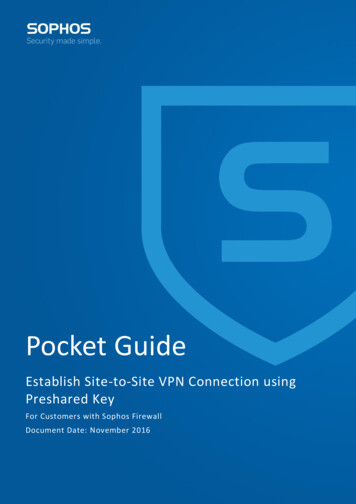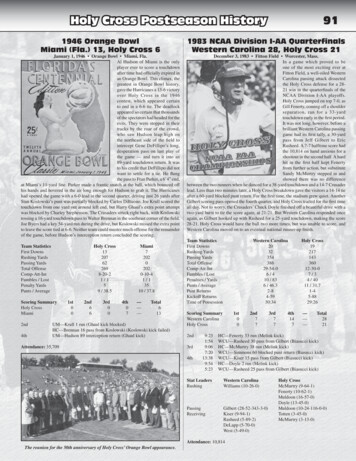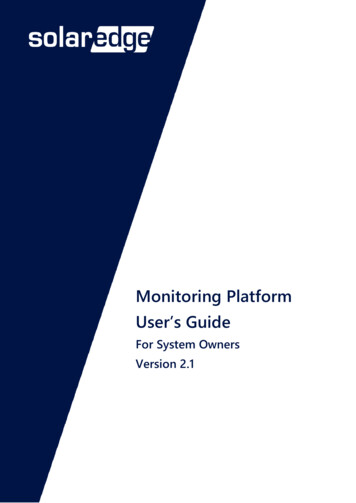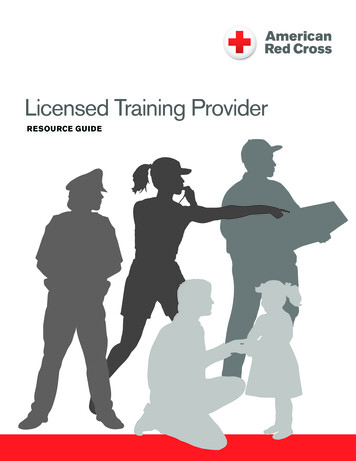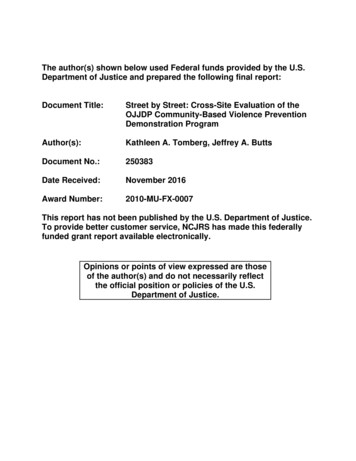
Transcription
The author(s) shown below used Federal funds provided by the U.S.Department of Justice and prepared the following final report:Document Title:Street by Street: Cross-Site Evaluation of theOJJDP Community-Based Violence PreventionDemonstration ProgramAuthor(s):Kathleen A. Tomberg, Jeffrey A. ButtsDocument No.:250383Date Received:November 2016Award Number:2010-MU-FX-0007This report has not been published by the U.S. Department of Justice.To provide better customer service, NCJRS has made this federallyfunded grant report available electronically.Opinions or points of view expressed are thoseof the author(s) and do not necessarily reflectthe official position or policies of the U.S.Department of Justice.
STREET BY STREETCross-Site Evaluation of the OJJDP Community-BasedViolence Prevention Demonstration ProgramKathleen A. Tomberg and Jeffrey A. Buttswith Hannah Adler, Laila Alsabahi, Kwan-Lamar Blount-Hill, Michelle Cubellis, Sheyla Delgado, Douglas Evans, Alana Henninger, Jennifer Lynn-Whaley,Marissa Mandala, Megan O’Toole, Jennifer Peirce, Emily Pelletier, Caterina Gouvis Roman, Maggie Schmuhl, and Caitlin TaylorN ov e m ber 2016
STREET BY STREETPrefaceCopyrightby the Research and Evaluation Center at John Jay College of Criminal Justice,City University of New York (CUNY), and theOffice of Juvenile Justice and Delinquency Prevention (OJJDP), U.S. Department of Justice.John Jay College of Criminal Justice Research & Evaluation Center524 59th Street, Suite 605BMWNew York, NY 10019www.JohnJayREC.nycNovember 2016This project was supported by Grant No. 2010-MU-FX-0007 awarded by the Office of Juvenile Justiceand Delinquency Prevention, Office of Justice Programs, U.S. Department of Justice. Points of viewexpressed in this document are those of the authors and do not necessarily represent the officialpositions or policies of OJJDP or the U.S. Department of Justice.r e c o m m e n d e d c i tat i o nTomberg, Kathleen A. and Jeffrey A. Butts (2016). Street by Street: Cross-Site Evaluation of theOJJDP Community-Based Violence Prevention Demonstration Program. New York, NY: Researchand Evaluation Center, John Jay College of Criminal Justice, City University of New York.www.JohnJayREC.nycThis resource was prepared by the author(s) using Federal funds provided by the U.S.Department of Justice. Opinions or points of view expressed are those of the author(s) and do notnecessarily reflect the official position or policies of the U.S. Department of Justice
STREET BY STREETPrefaceTable of ContentsAcknowledgementsExecutive SummaryiChapter 1Background and Evaluation Goals1Chapter 2Brooklyn, New York9Chapter 3Denver, Colorado38Chapter 4Outcome Evaluation61Chapter 5Oakland, California78Chapter 6Washington, DC100Chapter 7Newark, New Jersey132Chapter 8Conclusions146References155www.JohnJayREC.nycThis resource was prepared by the author(s) using Federal funds provided by the U.S.Department of Justice. Opinions or points of view expressed are those of the author(s) and do notnecessarily reflect the official position or policies of the U.S. Department of Justice
STREET BY STREETPrefaceAcknowledgementsThis report was prepared with support from the Office of Juvenile Justice and DelinquencyPrevention (OJJDP), part of the U.S. Department of Justice and its Office of JusticePrograms (OJP). The authors are grateful to the staff and leadership of OJJDP for theirguidance and support during the development of this project. The authors are alsoespecially grateful to Dr. Caterina Roman and the staff of the Institute for Social Researchat Temple University who designed and implemented the project’s household surveys inBrooklyn and Denver.The design and execution of a complicated project requires the efforts of many people. Theauthors are very grateful for the support and advice of the Office for the Advancement ofResearch and the Office of Sponsored Programs at John Jay College of Criminal Justice, aswell as assistance received from all current and former colleagues from the Research andEvaluation Center who contributed to this report: Hannah Adler, Laila Alsabahi, RebeccaBalletto, Kwan-Lamar Blount-Hill, Michelle Cubellis, Sheyla Delgado, Douglas Evans,Alana Henninger, Jennifer Lynn-Whaley, Marissa Mandala, Megan O’Toole, JenniferPeirce, Emily Pelletier, Maggie Schmuhl, and Caitlin Taylor.CBVP CitiesWe would like to thank everyone from the CBVP communities who providedthe study team with information and assistance during this project.BrooklynRuby-Beth Buitekant, Sharon Ife Charles, Amy Ellenbogen, Allen James,Rev. Kevin Jones, Marlon Peterson, Derick Scott, Rudy Suggs, and LevonWalker.DenverLeo Alirez, Christina Amparan, Paul Callanan, Jessica Cassarino, Jeff Fard,Mark Fleecs, Deborah Garcia Sandoval, Patrick Hedrick, Katie Hester,Kasandra Ornelas, Jon Rhodes, Ted Romero, and Johnny Santos.NewarkAllison Accettola, Ramid Brown, Cassandra Dock, Antonio Fernandez, EricIngold, Ingrid Johnson, Genna Jones, Lora Krsulich, and Al-Tariq Shabazz.OaklandJennifer Argueta, Sara Bedford, Dyanna Christie, Kevin Grant, JosieHalpern-Finnerty, Reygan Harmon, Emilio Mena, Ali Ar Rasheed, PageTomblin, and Akil Truso.Washington, DCJasmin Benab, Donyeè Bradley, Kiah Campbell, Maria Corrales, John DeTaeye, Penelope Griffith, Assistant Chief Diane Grooms, Ronell Johnson,Walter Johnson, Adam Levner, Mauricio Lopez, Elizabeth Malomo, LeroyMcDonald, Delbert McFadden, Dawn Moreland, Donald Parker, FernandoRomero, Carmona Ross, Josue Salmeron, Eric Shuler, Didier Sinisterra,T.N. Tate, Carlos Ticas, and Marian Urquilla.www.JohnJayREC.nycThis resource was prepared by the author(s) using Federal funds provided by the U.S.Department of Justice. Opinions or points of view expressed are those of the author(s) and do notnecessarily reflect the official position or policies of the U.S. Department of Justice
STREET BY STREETPrefaceExecutive SummaryThe Office of Juvenile Justice and Delinquency Prevention (OJJDP) providedfunds to the Research and Evaluation Center at John Jay College of CriminalJustice (JohnJayREC) to conduct a process and outcome evaluation of the Office’sCommunity Based Violence Prevention (CBVP) demonstration in five citiesacross the United States. Programmatic grants in the CBVP demonstration variedin amount, but were typically 2 million per city. The funds usually supportedprojects for two to four years between 2010 and 2014.All the city projects in CBVP shared common elements, such as their overallobjectives and core principles, an inter-agency collaborative approach, a focus onspecific geographic areas, demographic groups and identified “high risk” youth.Cities varied, however, in the implementation of their strategies. Not surprisingly,the cities also differed in the nature, dynamics, and driving factors behind youthviolence and gang activity in their local areas. This influenced the overall designand implementation of the program, as well as the type and availability of data.Although the five city projects all included law enforcement, youth services, jobtraining, and other nonprofit social services, the structure and content of theseinstitutional roles assumed different configurations in each location. This isclear in the project management structure across cities. In three sites – Oakland,Newark, and Denver – a specific city agency led project development and implementation, with service provision assigned to nonprofit organizations. InBrooklyn and Washington, DC, nonprofit organizations with strong neighborhoodroots designed and implemented the programs. In these cases, they collaboratedclosely with key city agencies (notably, the police, probation, and youth services)and with other nonprofit service providers.Many details of program implementation were different in each CBVP location,regardless of the institutions involved. Some cities had teams in which a coherentstaff group with clear roles supervised the majority of program activities,including monitoring their data about services and outcomes. Other cities had amore diffuse approach, with staff from multiple organizations holding programresponsibilities and minimal coordination from a single entity. While one of thestrengths of the OJJDP-CBVP funding model was its emphasis on adaptationto local context and needs, this variation across program sites posed seriouschallenges for the evaluation team’s efforts to assess and compare the experiencesand outcomes in each city.The CBVP program in Brooklyn took place in one sector of Crown Heights, aneighborhood with a long record of high crime and violence that more recentlybegan to face gentrification. The Crown Heights CBVP program was arguablythe most coherent in its theoretical model and the most comprehensive in itsimplementation. The Center for Court Innovation, a large and well-knownnonprofit organization, developed the program “Save Our Streets (SOS) CrownHeights,” which is based entirely on the public health model of violence interruption known as “Cure Violence.” The central idea in this approach is that violencewww.JohnJayREC.nycThis resource was prepared by the author(s) using Federal funds provided by the U.S.Department of Justice. Opinions or points of view expressed are those of the author(s) and do notnecessarily reflect the official position or policies of the U.S. Department of Justicei
STREET BY STREETPrefaceis transmitted within a community like a contagious disease, and that lawenforcement tactics (arrests, threats of prosecution) are not a sufficient long-termresponse. The program treats violence as a “virus” that can be “interrupted” orhalted through interventions that alter community norms (such as toleratingviolence as a ‘normal’ way to solve conflicts). During the CBVP project, violentcrime fell across Brooklyn as a whole, and it was impossible to discern anyreduction in crime that could be attributed to the program.A local nonprofit organization led the CBVP project in Washington, DC.The Collaborative Solutions for Communities (known colloquially as TheCollaborative) implemented the Creating Solutions Together (CST) programin the Columbia Heights and Shaw neighborhoods of central Washington from2010 to 2013. The program model was inspired by a previous project, the GangIntervention Project, which had been in place since 2003 and mapped out gangdynamics and incidents, enabling more focused and strategic responses by policeand social services.The CST program employed a core group of outreach workers who were familiarwith the youth and their contexts. Outreach workers drew heavily on the publichealth and violence interruption model of Cure Violence (Chicago) in fashioningtheir methods for responding to acts of violence—at hospitals, funerals, schools,and in the streets. The outreach workers used mediation and “cooling down”tactics with individuals or groups to prevent retaliation. The program also offeredservices to at-risk youth who needed help finding pathways out of violence.Services often included counseling, GED education, and job training programs.Crime data from the neighborhoods in Washington, DC were not specific enoughto discern a clear effect of the program on youth violence in targeted areas,although the amount of violent crime committed by juveniles citywide declinedbetween 2006 and 2014.In Denver, local government took the lead in program implementation. The GangReduction Initiative of Denver (GRID) focused specifically on gang violencein five sectors of Denver and it drew heavily on an established approach: theComprehensive Gang Model (CGM). This model entails social services andsupports for youth, in combination with law enforcement “suppression” tacticsand the threat of legal penalties for group-affiliated youth who commit gunviolence (similar to focused deterrence).Violent crime trends in Denver were generally stable or slightly increasing duringthe CBVP project period (2010-2014), but the City’s crime data were not specificenough to determine whether or not the program was responsible for any of thechanges. Denver experienced an increase in gang-related arrests that coincidedwith GRID implementation, but researchers could not determine whether thiswas due to the implementation of focused deterrence or if it was simply due toa more general “crackdown” tactic by police. Nonetheless, the GRID programundeniably catalyzed new and constructive inter-agency relationships andapproaches to youth and violent crime in general–the effects of which may stillemerge.www.JohnJayREC.nycThis resource was prepared by the author(s) using Federal funds provided by the U.S.Department of Justice. Opinions or points of view expressed are those of the author(s) and do notnecessarily reflect the official position or policies of the U.S. Department of Justiceii
STREET BY STREETPrefaceThe City of Newark developed the CBVP program under the name Newark UnitedAgainst Violence (NUAV), and it began implementation in 2013 in the Southand Central Wards, with joint leadership by the Newark Office of Reentry andthe Newark Police Department. The NUAV, like other CBVP cities, took a hybridapproach to existing violence-reduction models, and combined hotspot policing,focused deterrence, and some elements of the violence interruption public healthmodel (Cure Violence). Data on violent crime and youth crime in Newark, likeother cities, showed an overall decline. However, data for the specific programareas and participants were not available in Newark. Thus, it was not possibleto determine whether the program had any effect on youth crime in the targetedprogram area.The City of Oakland, led by the Department of Human Services, implemented itsCBVP demonstration project known as Oakland Unite. The primary model thatshaped the Oakland project was Cure Violence (public health and violence interruption), although Oakland also added elements of focused deterrence. OaklandUnite focused on specific neighborhoods and on the young people (under 25)most involved in violence, as victims and perpetrators. Data about crime trendsin Oakland showed a notable decline in both shootings and homicides from 2012to 2014. Moreover, the declines were stronger in the specific neighborhoodswhere Oakland Unite was most active. The intensity of program activity may havebeen associated with the more dramatic declines in shootings and homicides, butbaseline and/or comparison data to determine a clear effect were not available.Oakland Unite is generally seen as an initiative that brought together disparateagencies into a more coherent approach to gang violence, and many of itsactivities have been sustained past the end of the grant because the City successfully passed new revenue sources dedicated to violence prevention.In two CBVP demonstraton sites, Brooklyn and Denver, the Research andEvaluation Center also conducted an outcome analysis using a survey ofhouseholds. The surveys measured changes in attitudes and perceptions ofviolence over a two-year period and focused on four key concepts: disinclinationtoward gun violence, disinclination toward non-gun violence, perceived senseof safety in the neighborhood, and neighborhood efficacy or pro-social action.The results failed to detect clear effects of CBVP programming. In Brooklyn,the relative difference in neighborhood safety scores actually worsened, but thiswas due to the fact that equivalent scores in the comparison area improved–forreasons likely unrelated to CBVP. In Denver, there was some improvement inresidents’ sense of safety in the program area, but not a statistically significantdifference when contrasted with the comparison area.While these results may seem to reflect less change than expected, it should notbe surprising that no significant improvements in attitudes and perceptions wereevident after only two to three years of program activity. Additional research overa longer period of time and with sufficient complexity to capture the inherentvariations in individuals’ experiences and involvement with program activitiesmay have revealed more meaningful effects of CBVP intervention.www.JohnJayREC.nycThis resource was prepared by the author(s) using Federal funds provided by the U.S.Department of Justice. Opinions or points of view expressed are those of the author(s) and do notnecessarily reflect the official position or policies of the U.S. Department of Justiceiii
STREET BY STREETPrefaceThe John Jay evaluation measured the possible effects of the CBVP initiativeusing a very rigorous standard—i.e. large-scale changes in violent crime anddetectable improvements in attitudes about violence among the general public.Given the different approaches used in the five CBVP cities, the variations intheir program designs and implementation efforts, and the different types of dataavailable to researchers in each city, it was not possible for the evaluation to drawstrong conclusions about the effects of the CBVP demonstration as a whole. Ineach city, however, researchers identified some potentially beneficial effects of theinterventions implemented as part of CBVP. This report describes the efforts ofeach city and the lessons learned during implementation of CBVP.www.JohnJayREC.nycThis resource was prepared by the author(s) using Federal funds provided by the U.S.Department of Justice. Opinions or points of view expressed are those of the author(s) and do notnecessarily reflect the official position or policies of the U.S. Department of Justiceiv
Photo from the United States Capitol Historical SocietyCHAPTER 1Background andEvaluation GoalsThis resource was prepared by the author(s) using Federal funds provided by the U.S.Department of Justice. Opinions or points of view expressed are those of the author(s) and do notnecessarily reflect the official position or policies of the U.S. Department of Justice
Background and Evaluation GoalsSTREET BY STREETIntroductionIn 2010, the U.S. Department of Justice’s Office of Juvenile Justice andDelinquency Prevention (OJJDP) issued a pair of grant solicitations under theCommunity-Based Violence Prevention (CBVP) program to support several citiesin new initiatives to reduce youth violence at the community-level. The solicitations offered program demonstration grants for community applicants as wellas a separate grant for an evaluator to monitor and assess the demonstrations.The community grants provided funding to improve federal, state, and localresource coordination that enabled cities to replicate evidence-based strategies toreduce violence. Two of those strategies were Cure Violence (previously known asChicago CeaseFire) and the Boston Gun Project (also known as Boston Ceasefireand later Group Violence Intervention, which is sponsored by the NationalNetwork for Safe Communities at John Jay College).The CBVP demonstration grant asked recipient cities to target selected intervention strategies on youth and young adults who engage in high-risk activities andwho are most likely to be involved in violence in the immediate future, eitheras victims and/or as perpetrators. The Research and Evaluation Center at JohnJay College of Criminal Justice received the CBVP evaluation grant and focusedits research efforts on the first five CBVP grantees: Brooklyn, NY; Denver, CO;Newark, NJ; Oakland, CA; and Washington, DC.Legislative HistoryThe Department of Justice (DOJ) requested 25 million in appropriations fromthe 111th Congress in 2009 (FY 2010) to support community-based violenceprevention initiatives using a public health approach (Office of Management andBudget 2009). The Administration justified the request on the growing body ofresearch establishing the success of strategies to reduce violence in communitieswithout an exclusive reliance on law enforcement. Specifically referencing theBoston Gun Project and Chicago CeaseFire (or Cure Violence), the requestoutlined general best practices used by successful violence reduction programs inmultiple (anonymous) cities across the United States.As described in the FY2010 budget request, best practices included “street-leveloutreach, conflict mediation, and the changing of community norms to reduceviolence, particularly shootings.” These practices were assumed to contributeto decreased gun violence and retaliatory murders, fewer shooting hot spots,more direct assistance for high-risk youth, and improved neighborhood safety.The Department of Justice asserted that the public health approach was fundamentally different from other violence reduction programs although it did notelaborate on the differences. The President’s Budget paralleled DOJ’s justifications for community-based violence prevention initiatives, broadly referencingprior successes in violence reduction when those efforts incorporate a publichealth approach.www.JohnJayREC.nycThis resource was prepared by the author(s) using Federal funds provided by the U.S.Department of Justice. Opinions or points of view expressed are those of the author(s) and do notnecessarily reflect the official position or policies of the U.S. Department of Justice1
STREET BY STREETBackground and Evaluation GoalsAlthough sub-committee budget hearings held by the Senate AppropriationsCommittee did not include detailed discussions about community-based violenceprevention initiatives, then-Attorney General Holder mentioned the grant programin a written response following the hearing (Department of Commerce 2009).Responding to questions about crime prevention, the Attorney General reiteratedthe justifications for funding community-based violence prevention. The SenateAppropriations Committee declined to recommend a specific amount of funding tocommunity-based violence prevention initiatives, but a Committee budget reportlisted community-based violence prevention as a funding category under the Officeof Juvenile Justice Delinquency Prevention (Congressional Record 2009).In the same year, the U.S. House of Representatives’ Committee on Appropriationsreleased a budget report containing an 18 million allocation to community-basedviolence prevention and recommended its consideration by the entire House(House of Representatives 2009). The Committee report described communitybased violence prevention initiatives as strategies with a “focus on street-leveloutreach, conflict mediation, and the changing of community norms to reduceviolence.” The report language reflected the best practices described in theDepartment of Justice budget request.Following these initial budget reports, the Senate and House budgets wereconsolidated to fund community-based violence prevention initiatives under theCommerce, Justice, Science, and Related Agencies division of the ConsolidatedAppropriations Act of 2010. The discrepancy between the 18 million allocationby the House of Representatives and the lack of explicit allocation by the Senateresulted in a 10 million allocation for community-based violence preventioninitiatives. Approved by the House and the Senate, followed by the President’ssignature, the 111th Congress appropriated 10 million from the federal budget forcommunity-based violence prevention initiatives. As stated in the ConsolidatedAppropriations Act, the 2010 federal budget included the 10 million in alignmentwith the Juvenile Justice Delinquency Prevention Act, which authorizes the Officeof Juvenile Justice and Delinquency Prevention to provide funds through discretionary grants (Juvenile Justice Delinquency Prevention Act 2002). At finalpassage, the budget failed to include any of the previous language about the “publichealth model” or even any other specific guidance about intervention approaches.The appropriation process for community-based violence prevention in fiscal year2011 included less discussion on Congress’ expectations than the 2010 process.For fiscal year 2011, the Department of Justice and the White House requested 25 million in funding for community-based violence prevention, based on thesame general justifications in the 2010 request. The request for 25 million wasthe same amount requested for fiscal year 2010 and reflected an increase of 15million above the 2010 appropriation. Based on the President’s Budget, the SenateAppropriations Committee allocated 20 million for community-based violenceprevention, but Congressional debate resulted in passage of continuing resolutionsand acts to fund government activities in 2011 at levels similar to 2010. The finalappropriation of 10 million for community-based violence prevention initiativeswas based on the 2010 appropriation (Department of Defense and Full-YearContinuing Appropriations Act 2011).www.JohnJayREC.nycThis resource was prepared by the author(s) using Federal funds provided by the U.S.Department of Justice. Opinions or points of view expressed are those of the author(s) and do notnecessarily reflect the official position or policies of the U.S. Department of Justice2
Background and Evaluation GoalsSTREET BY STREETCBVP SolicitationsIn 2010 and 2011, the Office of Juvenile Justice and Delinquency Preventionreleased a series of solicitations for applications to fund community-basedviolence prevention initiatives. One solicitation (the demonstration solicitation) was for programs seeking funds to implement community-based violenceprevention strategies. The other solicitation (the evaluation solicitation) was foran evaluation partner who would assess the successfulness of the CBVP programsin the funded cities. The demonstration solicitation was issued in early 2010 andagain in early 2011 to add more cities to the program, while the evaluation solicitation was only issued once in early 2010.The solicitations identified the broad goals of the CBVP appropriation andelaborated on the purpose, objectives, and expected deliverables (e.g., reports,publications) from the applicants. The demonstration solicitations soughtapplicants to reduce gun violence in specific communities through the replicationof evidence-based programs. The OJJDP named Cure Violence, the Boston GunProject, and the Richmond Comprehensive Homicide Initiative as examplesof evidence-based programs with demonstrated effectiveness in reducing gunviolence. The Richmond Homicide Initiative appeared as an example of a publichealth model to decrease violence for the first time in the 2010 solicitation. Itwas not included as an example during the formal budget allocation process.Applicants were encouraged to select from among these or other strategies thatcould be described as evidence-based, as long as they believed a specific approachwould work well in their community.Applicants were not restricted to replications of specific models and the solicitation did not require projects to be backed by a specific type of evidence. Thekey components of violence reduction named in the CBVP solicitations naturallybecame the preferred strategies for demonstration applicants—i.e. changingcommunity norms surrounding violence, providing non-violent conflict resolutionalternatives to violence, and increasing public awareness of the harms of violence.The agency directed applicants to identify geographic areas at high risk for gunviolence and to propose strategies that would engage the efforts of outreachworkers, clergy, and community leaders. Applicants were also encouraged toinclude law enforcement partnerships and community education campaigns.The solicitations emphasized that the CBVP program intended to support andenhance existing anti-violence strategies within applicant communities. Thus,every grantee received federal funding to expand programs that were alreadyunder way with pre-existing methods and partnerships.The application process required projects to provide data about current levels ofviolence in their communities and to supply information about the disproportionate involvement of groups, either as the perpetrators or victims of violence.Small groups (e.g., gangs, cliques, and crews) could be named as the targetpopulation for a CBVP demonstration. Applicants were asked to provide documentation (ideally in the form of a map) identifying the size, scope, and effectsof violence involving any targeted groups. Specifically, the demonstrationwww.JohnJayREC.nycThis resource was prepared by the author(s) using Federal funds provided by the U.S.Department of Justice. Opinions or points of view expressed are those of the author(s) and do notnecessarily reflect the official position or policies of the U.S. Department of Justice3
Background and Evaluation GoalsSTREET BY STREETFocused DeterrenceOne of the violence prevention models endorsed by CBVP solicitations was the Boston Gun Project. Developed in response to anincrease in homicides in the 1990s, particularly among youth, the project attempted to de-escalate potentially violent situationsby conducting street outreach, connecting youth with services, and organizing meetings (or “call-ins”) for gang-involved youth(Kennedy et al. 2001). At these meetings, police, community leaders, and relatives of gunshot victims would express theirdisapproval of the gun violence and its harms, as well as their commitment to helping youth involved in gangs to find alternatives.Law enforcement leaders would warn youth that their entire violent group (i.e. gang or crew) would be held accountable for theviolent behavior of any individual members through strict enforcement of all relevant laws.The project was an effort to shape behavior with the power of group norms and accountability, and to shift the community awayfrom accepting gun violence. The Boston Gun Project implemented targeted interventions—including both the “call-ins” and socialservices to provide alternative life paths—aimed at a single group at a time to focus on chronic offenders and leaders. The projectemerged in part from the realization, through discussion among stakeholders and community members, that fear and concernsabout status—rather than instrumental reasons—were key driver
New York, NY 10019 . www.JohnJayREC.nyc . November 2016 . This project was supported by Grant No. 2010-MU-FX-0007 awarded by the Ofice of Juvenile Justice and Delinquency Prevention, Ofice of Justice Programs, U.S. Department of Justice. Points of view expressed in this document are those of the authors and do not necessarily represent the oficial

